
Please send all Checks and Money orders to :
Dave Taylor P.O. Box 87 Sylvania, OH 43560
419-842-1863
Click Here to E-mail Us!

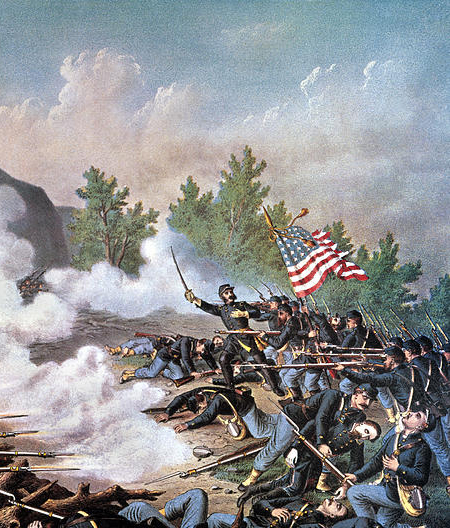
17-06-12

17-08-01…1860 COLT ARMY … The classic Civil War army revolver. .44 caliber, six-shots, the standard issue pistol for Federal cavalry, and a nice prize for any Confederate trooper lucky enough to capture one. Mosby stated the Colt Army revolvers were his favorite sidearms. He always carried a brace of them (pair) on his mount, and he owned at least two pair during his service, both sets taken from Yankee prisoners. Our Colt has matching serial numbers: 134554, making it an 1863 production gun, a good year for participation in the major cavalry campaigns of the war in both the eastern and western theaters. Good grips with tight fit to the frame, showing some minor dings, but a visible inspector cartouche on the lower right grip. Medium tone to the brass trigger guard, smooth gray metal overall with some dings to the cylinder, legible barrel markings, cylinder patent stamp and number, and even some light traces of the cylinder scene are still present. Mechanics are good. Nipples are not battered. Wedge screw slot is a bit buggered, otherwise just some normal signs of wear and actual field use. An essential Civil War sidearm for the martial arms, Colt, and cavalry collector.
$1,650.00
sold
Call us @ 419-842-1863

17-08-02… SINGLE YANKEE COLONEL’S SHOULDER STRAP: …
Elegant double-bordered bullion colonel’s shoulder strap, with some oxidation but lots of gilding still on the bullion border and the silver eagle still showing brightness on the sequins and a sliver of red on the beak. Characteristic Civil War construction with alternating dull and bright bullion threads on the border, and a velvet background material. This was originally finished with a piece of brown polished cotton on the back. This cotton is mostly gone exposing the multitude of threads securing the bullion to the velvet background material. Colonel straps have always been scarce, at fewer than one in thirty sets given the organization of the army. This one has the additional lure of being very showy and a step up in class with its double border of bullion. If you can find a matching second strap you will have a $700 set. The single strap…. $175.00 sold
Call us @ 419-842-1863
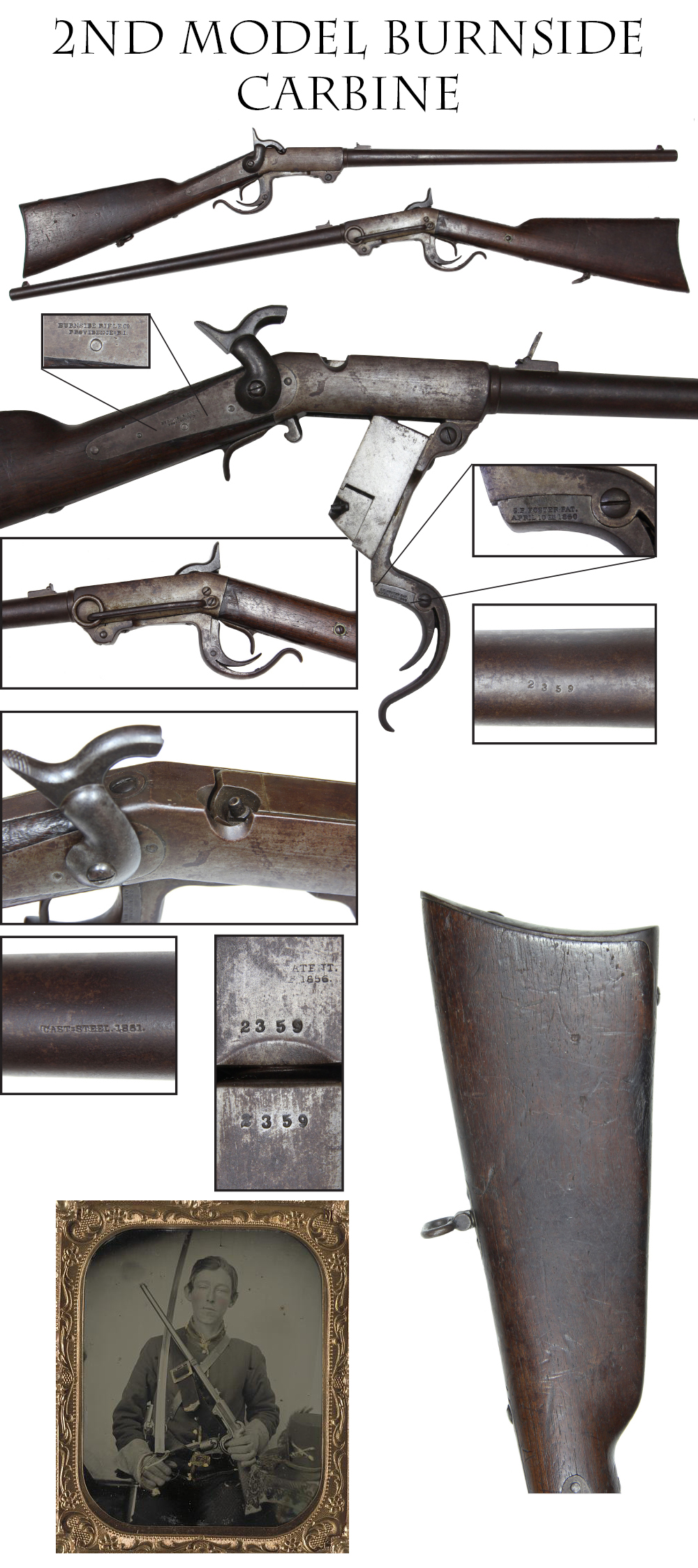
17-08-03…2nd MODEL BURNSIDE CARBINE: Only about 2,000 of these second models were made in 1861 and 1862. Instantly recognizable because it used no forearm, these carbines were numbered consecutively with the first models, which had used a tape primer. Overall Very Good condition. This one is serial number 2359 and shows legible Burnside Rifle Company and Burnside patent stamps overall, as well as the “Cast-Steel 1861” barrel stamp. The patent stamp on the breech is just a tad light on the left. The stock has good color, shows a few use dings, but has a tight fit to the frame, with a few dings behind the hammer. The frame shows a mix of gray and translucent brown, the nipple is good and the mechanics fine. The barrel has full coverage of brown patina. The sights are in place, with the rear sight showing some blue. The breech block is largely silver gray, with perhaps some hints of faded case on the edges of the lever. The butt swivel, sling ring and side bar are in place. These carbines were issued to many cavalry regiments, including the 1st Maine and 1st New Jersey, but they also made their way into the hands of the First Rhode Island Infantry for use at First Bull Run. 100% original. 100% complete, and mechanically perfect. A key Civil War carbine, and very scarce as well…. $3,500.00
Call us @ 419-842-1863
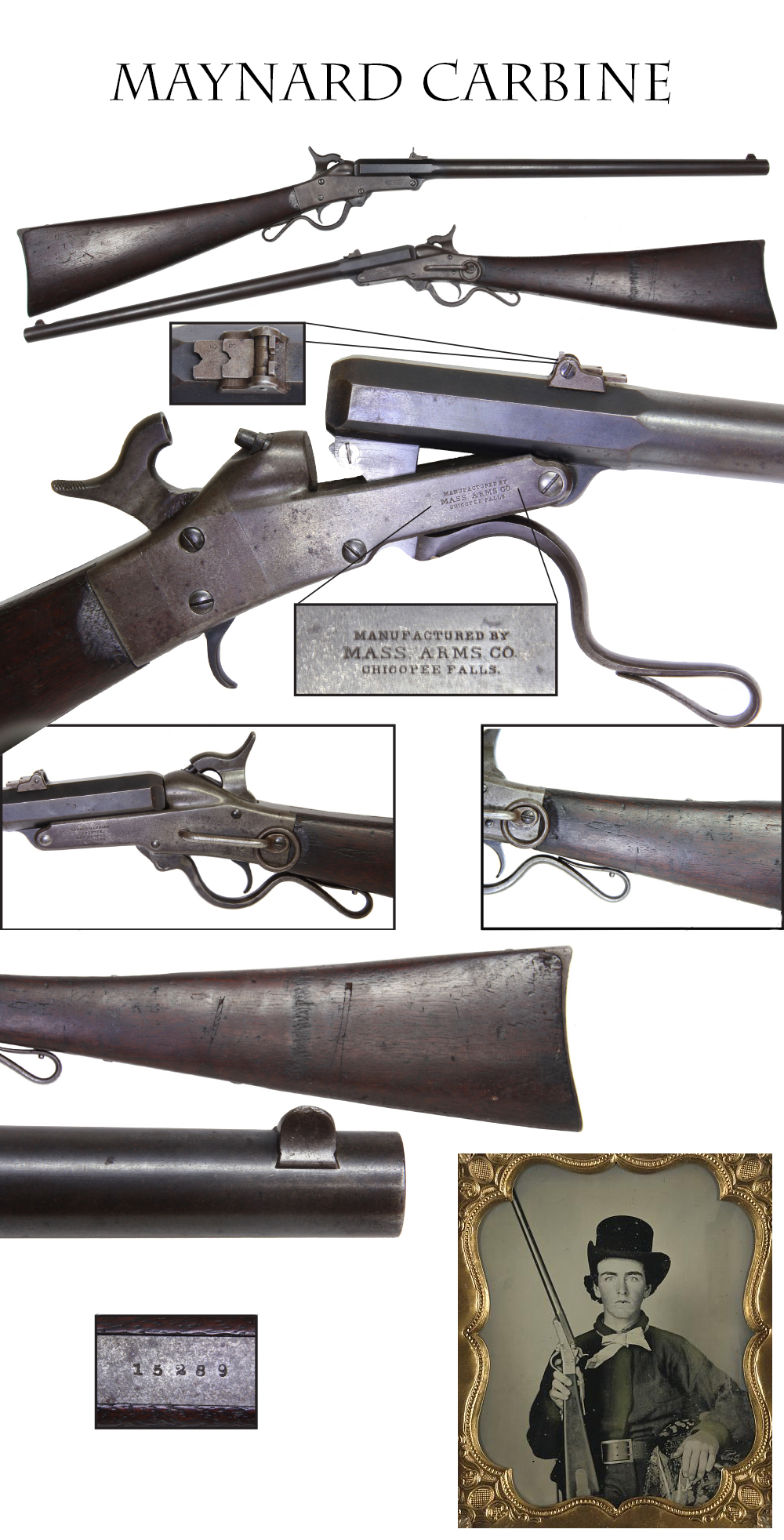
17-08-04….MAYNARD CARBINE …Second model Maynard, serial number 15289, very good condition and showing some real cavalry use. Smooth plum patina on the metal, with the barrel still showing some blue around the breech and the rear sight. Mechanics are perfect. Mass. Arms manufacturing stamp at right frame is crisp. Nipple is fine. The wood shows some dings from wartime use and two vertical pairs of scratches about midway back that might have been a soldier’s beginning attempts to carve something before he realized that his talents lay elsewhere. For the cavalry aficionado, the wear marks between these pairs of scratches are really interesting because they are true signs of real “saddle wear” made by the edge of the roll bar in the cavalry carbine belt sling swivel, and the edge of the saddle rubbing against the wood. The Civil War troopers carbine had its muzzle secured in a small thimble attached to the quarter straps or D-ring, the saddle ring was clipped to the sling hook. As the horse plodded along the carbine butt stock would rub back and forth, back and forth, back and forth… resulting in the well known saddle wear marks we see on the left side of butt stocks on carbines and cowboy carried Winchesters. A good solid Maynard that was really there. $1,595.00
sold
Call us @ 419-842-1863

17-08-05….ABOUT MINT, DOUBLE INSCRIBED BEAUTIFUL AMES INSCRIBED 1850 FIELD AND STAFF SWORD OF DEWITT S. SMITH, 49th MASSACHUSETTS … Only one DeWitt S. Smith served as an officer in the Civil War. He was from Lee, Mass., and was a 22 year-old accountant. Business must have been good because he was able to carry into service this beautiful Ames Staff and Field officer’s sword with nearly all of the gilt on the hilt, all the blue finish on the scabbard, and a mint bright blade with vivid etching with all the frosty luster, and his name engraved in script both on the upper scabbard mount and the pommel cap of the sword. Smith enlisted on 9/27/62 and was commissioned 2nd Lieutenant on 10/28/62 in Co. H of the 49th Mass. This was a nine-month regiment recruited in response to Lincoln’s call for troops on August 4, 1862. William Francis Bartlett, formerly of the 20th Mass, was appointed colonel and the regiment reached Louisiana in February, 1862, where it joined the 19th Army Corps. If they hoped for a nine-month vacation in sunny climes, they were disappointed. In May they took part in the assault and siege of Port Hudson. 65 of their officers and men were part of the “forlorn hope” assault team on May 27, and in the fighting that day the regiment as a whole lost 16 officers and men killed and 64 wounded. The regiment remained in the trenches during the siege, suffering further casualties and after the surrender of that post took part in the expedition and fighting at Bayou Lafourche, where is lost another 3 killed, 5 wounded and 16 prisoners.
It finally returned to Baton Rouge and then New Orleans, from which it shipped out for home, arriving on Aug. 22 and mustering out November 1. The sword was a high-grade purchase at the time and is in truly superb condition now. Nearly mint. The sharkskin grip is about 100 percent and the twisted brass binding wire is in place. The leather pad is in place at the blade shoulder. Both pommel cap and upper mount of the scabbard are engraved with his name. The scabbard has all of its original deep blue, now oxidizing just slightly with brown tones. The drag has one small ding and there is one small rub mark on the inboard side of the scabbard just below the upper mount, which shows the Ames stamp. The blade is immaculate with bright steel and vivid etching showing frosting around the floral, military and patriotic motifs. It is a wonderful sword with a great inscription belonging to an officer who saw some tough service. Of some interest is that Google shows our Mr. Smith was America’s foremost coin collector after the Civil War. He apparently amassed a multi million dollar collection which is still referenced by numismatists to this day. A magficent CW sword…
$3,900.00
sold
Call us @ 419-842-1863

17-08-06… SNY BELT AND BUCKLE: This is the desirable puppy-paw or stud back SNY belt plate issued to many early war New York volunteers. The plate and flat C-clasp keeper have a very attractive, delicate, bronzish color, matching age patina. The belt is in very good shape, bridle leather and solid. The plate shows only expected honest wear, with no edge dings or bends. A very nice example of a very desirable plate on the original belt complete with the brass keeper. Same price as one we sold in 2016. $850.00 sold
Call us @ 419-842-1863
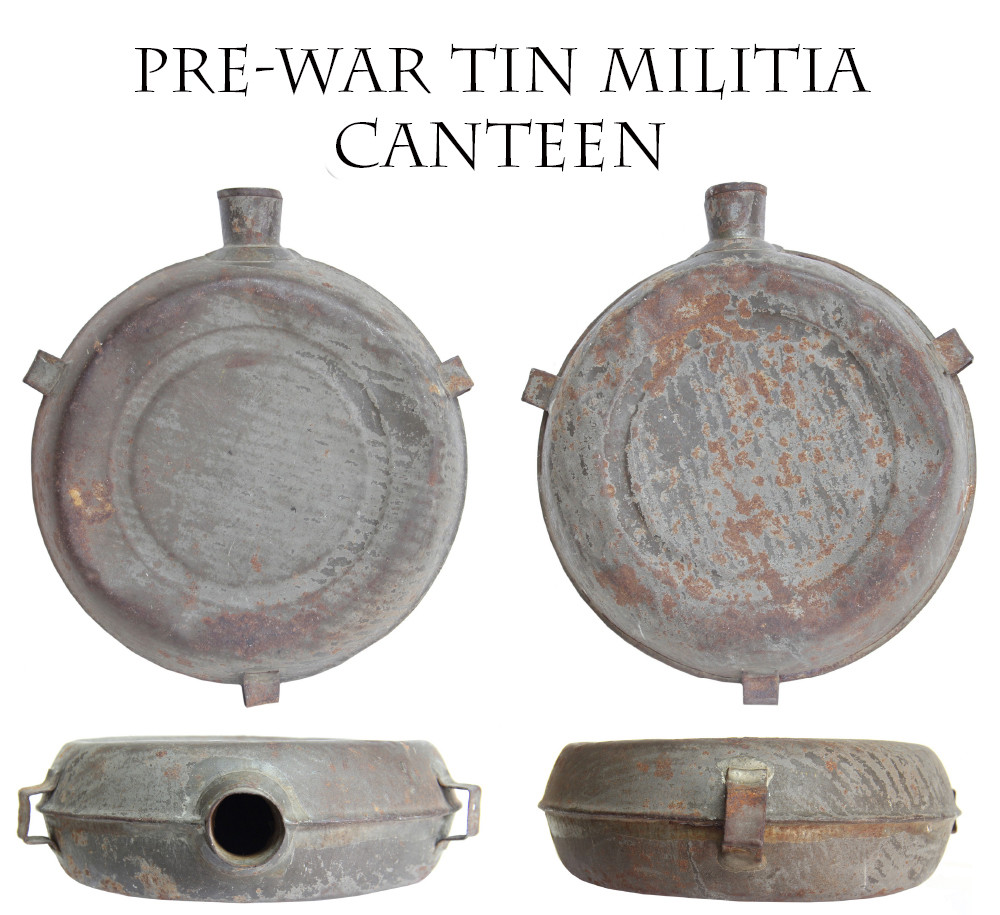
17-08-07…. PREWAR TIN MILITIA CANTEEN CORRECT FOR US OR CS DISPLAY Most dealers and collectors will optimistically label any tin drum style canteen “Confederate”. This one could well have been carried by a Johnny Reb, but the style is actually a commercial militia pattern that could have been acquired by any unit early in the Civil War, US or CS. I have owned a couple with documentation to 1861 New Hampshire soldiers, and have another similar example in my personal collection inscribed by and identified to a Penna soldier. This one has a concentric ring applied just inside the outer edge, somewhat like a signal corps canteen and is stamped out in two pieces joined by a raised soldered seam around the outer edge. Has all three square strap brackets for a shoulder sling, and the spout widens somewhat for easier insertion of a cork stopper that was likely retained by a simple string or cord. The tinned iron body shows some finish loss and the underlying iron shows brown, with some thin standing rust that adds character. A real nice example of a very scarce 1861 or earlier canteen. Hundreds of times rarer than the highly sought bullseye canteens, but not much more money… A fresh find… $325.00 sold
Call us @ 419-842-1863
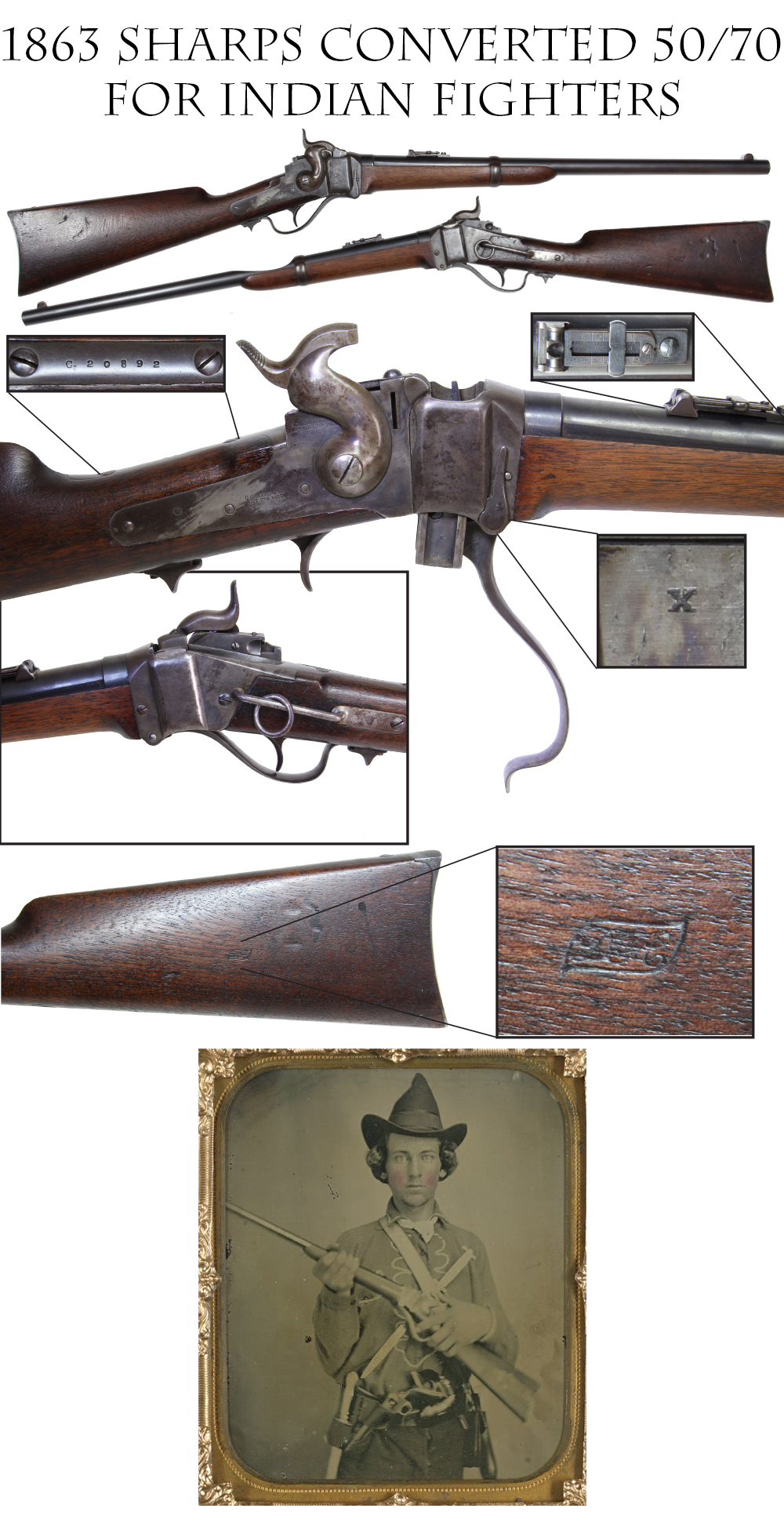
17-08-08… FINE CONDITION 1863 SHARPS .50-70 CONVERSION CAVALRY CARBINE … A beautiful .50-70 Indian War period Sharps metallic cartridge carbine. The government converted some 27,000 of these percussion Civil War Sharps carbines to .50-70 centerfire for use on the plains and they were a standard cavalry arm in the Indian Wars until phased out in 1870s by the trapdoor Springfields. This one has nearly all the beautiful arsenal blue remaining on the barrel, a lot of case colors on the frame and crisp wood. The mechanism is perfect, sights, band, sling bar and ring are in place. 100% original, 100% complete, and mechanically perfect. Perfect bore. Serial number C,20892. Lock markings are crisply legible, as is the Lawrence patent data on the rear sight. The frame markings show the standard slight weakening due to the refurbishing done at the arsenal. Likewise, as we frequently see, the barrel markings are burnished away, again from the process of refinishing at the arsenal in the late 1860s. Totally correct and proper. The “witness” mark is perfectly aligned where the breech meets the frame. The stock edges are sharp, the flats show some minor dents on either side and one drag line. Also has a crisp DFC/Ribbon cartouche on the left side of the butt stock which is the proper cartouche for a conversion Sharps. The sling bar shows some gray from the sling ring rubbing. Very pretty overall. Even the screwheads show off original blue. A sharp looking Sharps!
$2,495.00 sold
Call us @ 419-842-1863
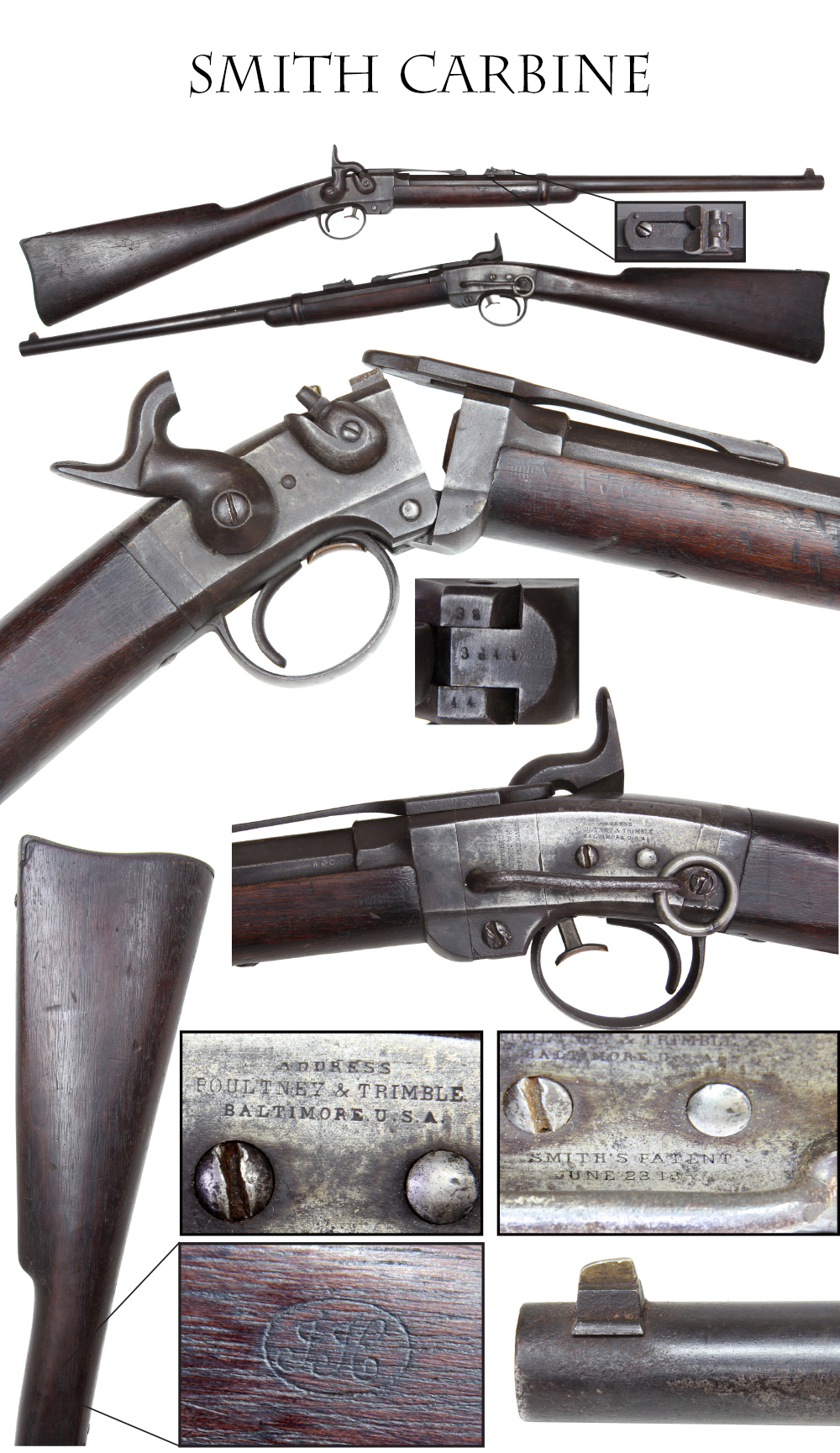
17-08-09….SMITH CARBINE..Smith carbines were carried by cavalry units including the 1st Connecticut, 17th Pennsylvania, 6th Ohio, 7th Illinois and many others. .50 caliber, the carbine breaks open in the middle like a shotgun for insertion of the cartridge which is separately primed in the standard way with a percussion cap. This one is in nice condition, serial number 3844. Legible American Machine Works, Springfield, Mass., manufacturers stamp on forward left side of frame and the usual Poultney & Trimble agent markings. Barrel proof is visible at left breech flat and there is a visible “JH” inspectors cartouche in the wood at the left wrist. The sling bar shows a slight bend from use, the ring is still present. Forearm and buttstock show just minor handling and use marks and have a good fit to the frame. Screw heads show some roughness and the front blade sight is an old replacement. The barrel shows lots of original faded blue and is generally smooth, with some shallow pitting and roughness right around the muzzle. The frame is smooth metal, mainly gray with some hints of faded blue on the bands adjoining wrist and forearm. Sights are present, action and mechanics are perfect. Bore is VG and could use a brushing. A key Civil War cavalry carbine that saw some use out west as well. Sergeant Custards men who were ambushed outside the Platt Bridge Station defended themselves to the last with Smith carbines as I recall… $1,550.00 sold
Call us @ 419-842-1863
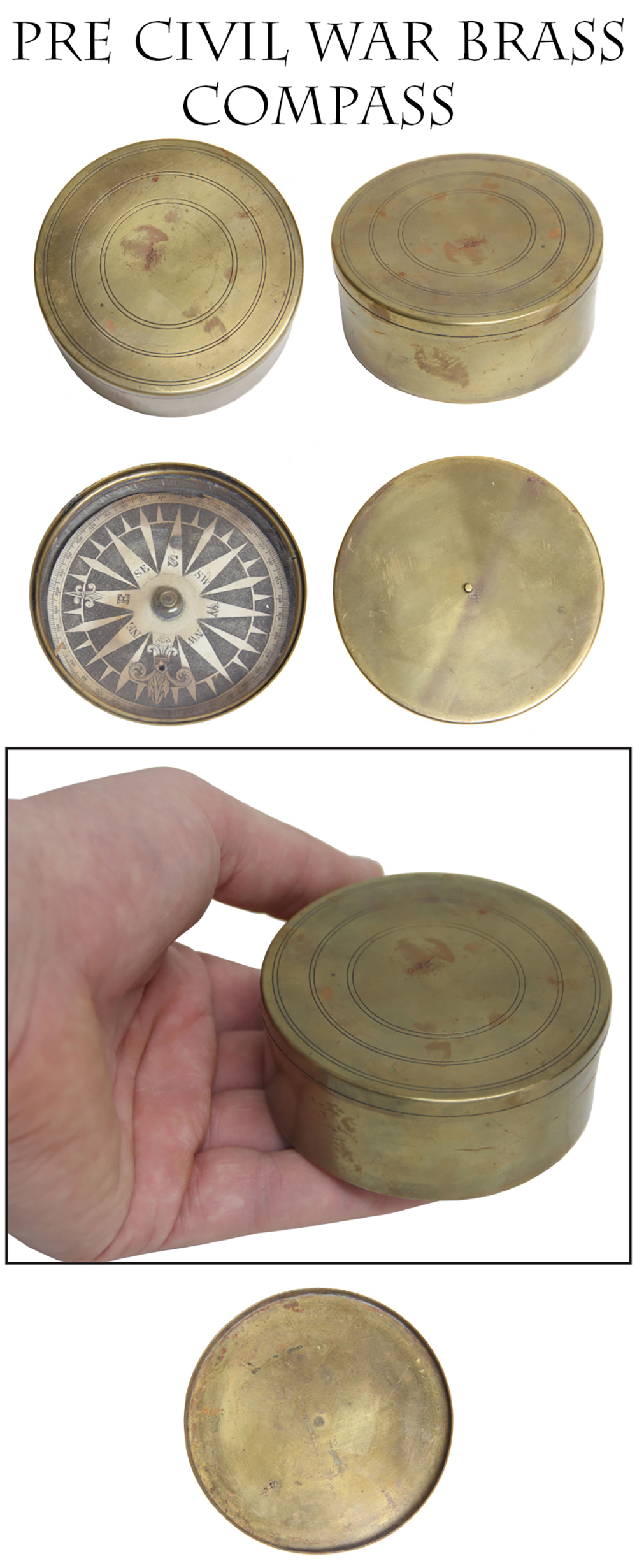
17-08-10….. CIVIL WAR OR EARLIER BRASS COMPASS …Early light weigh brass cased compass for travelers, sailors and the military. Has floating printed pasteboard dial. Some minor age spotting to the case. 3+ inches in diameter. 1.5 inches thick. Completely functional and perfect to display with military, frontier, or nautical items. We sometimes imagine frontiersmen or army scouts heading off into the wilderness guided by nothing but intuition and dead-reckoning. Truth is they had compasses and frequently sextants. As my Gt. Gt. Gt. Gt. Grandpappy said when queried about being lost in the wilderness…. ” LOST? I ain’t never been lost. I’ve been turned around for a month or two at a time, but I ain’t never been lost.” A nice display piece with Civil War officer’s effects, Frontiersman artifacts, or nautical items. Makes a striking display item. $235.00 sold
Call us @ 419-842-1863
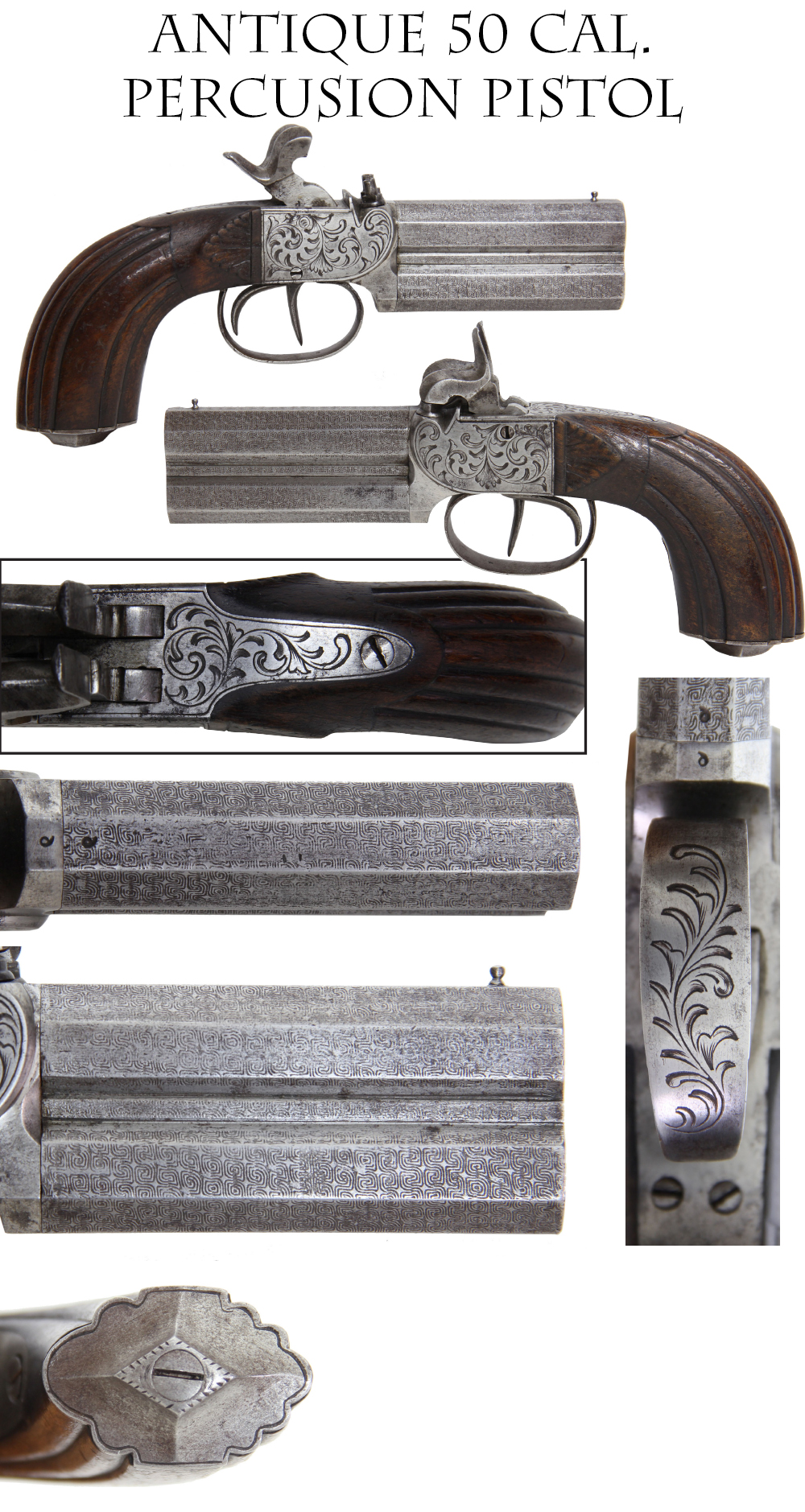
17-08-11….HIGH QUALITY DAMASCUS DOUBLE BARREL PERCUSSION PISTOL…A French or Belgian double barrel over and under percussion pistol. 8 inches overall length. Barrel and frame mating marks, no maker marks. Double hammer and double trigger arrangement with fluted and raised carved flaring grip and faceted butt cap. Frame and backstrap are deeply engraved with floral motifs. Octagonal barrels are beautifully and intricately Damascus patterned. Steel colored with just some slight graying. Good action. About .50 caliber, enough to make an impression on an assailant, with a back up barrel if he had a cohort. An impressive coat or pocket pistol from 1840 to 1850 era for walking out on the town. A front sight indicates some optimism in the skill of the holder and the distance at which he would likely have to engage. An impressive gentleman’s pistol zcejx $595.00
sold
Call us @ 419-842-1863
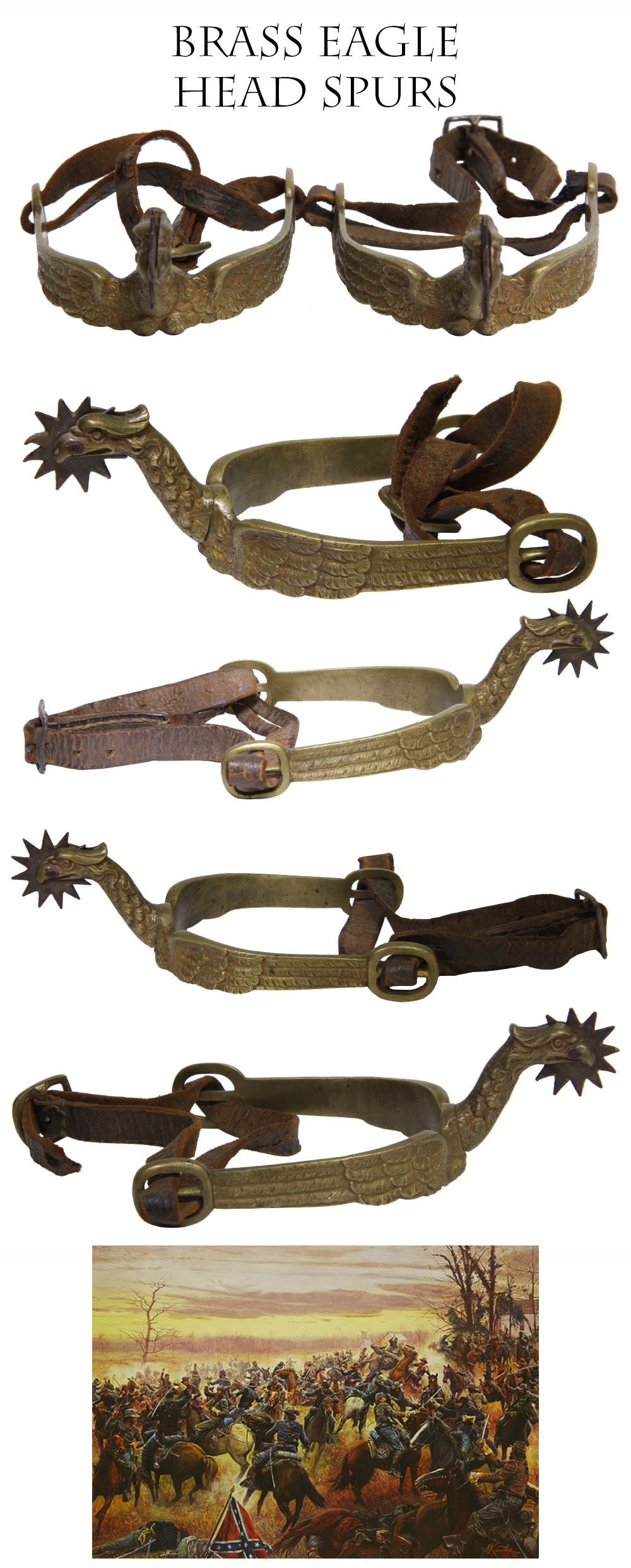
17-08-12… SUPERB BRASS EAGLE HEAD SPURS… A very high grade set of officer’s eagle head spurs. These were popular as presentation pieces to respected officers who would serve mounted. A number of different patterns were marketed by military outfitters such as Schuyler, Hartley and Graham, and Tiffany & Co. This pair is exceptional, with very detailed eagle’s heads, crest, neck feathers and plumage leading back to the side bars that are fully rendered as eagle wings extended all the way back to the strap slots. The rowels turn freely. I see only one tip slightly bent. There is an old set of leather straps on them that do not quite match, but these were often broken in use and replaced as needed. A very nice, even mellow tone to the brass. Eagle head spurs are, and always have been very rare and desirable. The two sets I have here both came from a high-end New England collection that was auctioned near Boston. I had to battle very hard to win them and do not anticipate seeing such high quality again any time soon. Among the best available. $2,450.00
Call us @ 419-842-1863

17-08-13…VERY EARLY AND EXQUISITE SOLID SILVER EAGLE HEAD SPURS… Truly impressive, very early, heavy cast, solid silver eagle head spurs. The eagle heads are similar in form to the pommels on pre-1812 Philadelphia style eagle head swords. The rowels are wonderfully designed as sunbursts that background and vignette the eagle’s head, much as the suns rays are used above and behind the American eagle on belt plates and hat insignia. The neck and chest feathers are rendered fully and with great detail. The wing feathers fade out and become lined panels, which extend back to hinges on the side bars, enabling them to be better tightened on the boot. These certainly date at least as far back as the Mexican War and may well date significantly earlier. A truly impressive set of officer’s spurs. Eagle head spurs are, and always have been very rare and desirable. The two sets I have here both came from a high-end New England collection that was auctioned near Boston. I had to battle very hard to win them and do not anticipate seeing such high quality again any time soon. Truly superb.
$2,950.00 sold
Call us @ 419-842-1863
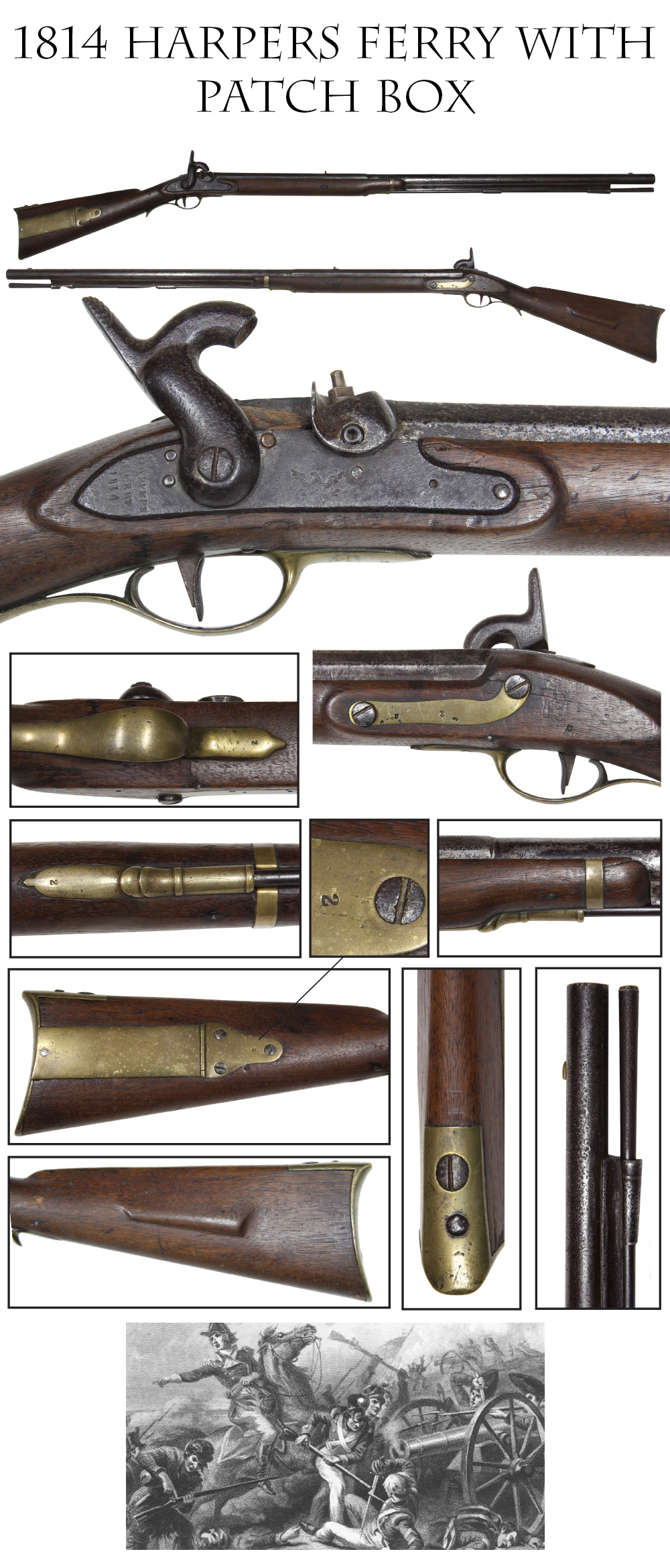
17-08-14… BUTTERFIELD ALTERED 1803 HARPERS FERRY 1803 RIFLE DATED 1814 … Rifle shortages in the War of 1812 mandated the return to production of the 1803 pattern rifle in 1814. This is one of those first year of production rifles made in time for the end of the war with clear lock plate markings: Harpers Ferry 1814 behind the hammer and a Harpers Ferry eagle forward of the hammer. At the beginning of the Civil War the state of Pennsylvania contracted with various Philadelphia area arms makers to alter to percussion old military flintlock rifles in its hands. This 1814 dated Harpers Ferry rifle shows the typical Butterfield alteration, cutting off the breech and mounting a chambered percussion breech with a clean-out screw. In this case our rifle shows evidence of having been shot in the mid 20th century. The clean-out screw in the bolster requires an allen wrench and the nipple is a modern replacement. Otherwise all the parts are original. The lockplate show some roughness, but the Harpers Ferry 1814 stamp is clearly visible at rear, as it the US eagle at center. The 36 inch, 58 caliber barrel is generally smooth with a mix of gray and dark spots and scattered shallow pitting at the breech and muzzle. The ramrod is the all steel trumpet style. The stock is VG with nice butt flats and tight fit to the metal. Some handling marks opposite the lock and a hairline that extends back to the upper screw. The assembly number “2” is stamped on a number of parts- used to keep them together during the conversion process. An historic War of 1812 rifle altered for potential use at the beginning of the Civil War. One of the most handsome of all US martial shoulder arms. $1,795.00
sold
Call us @ 419-842-1863
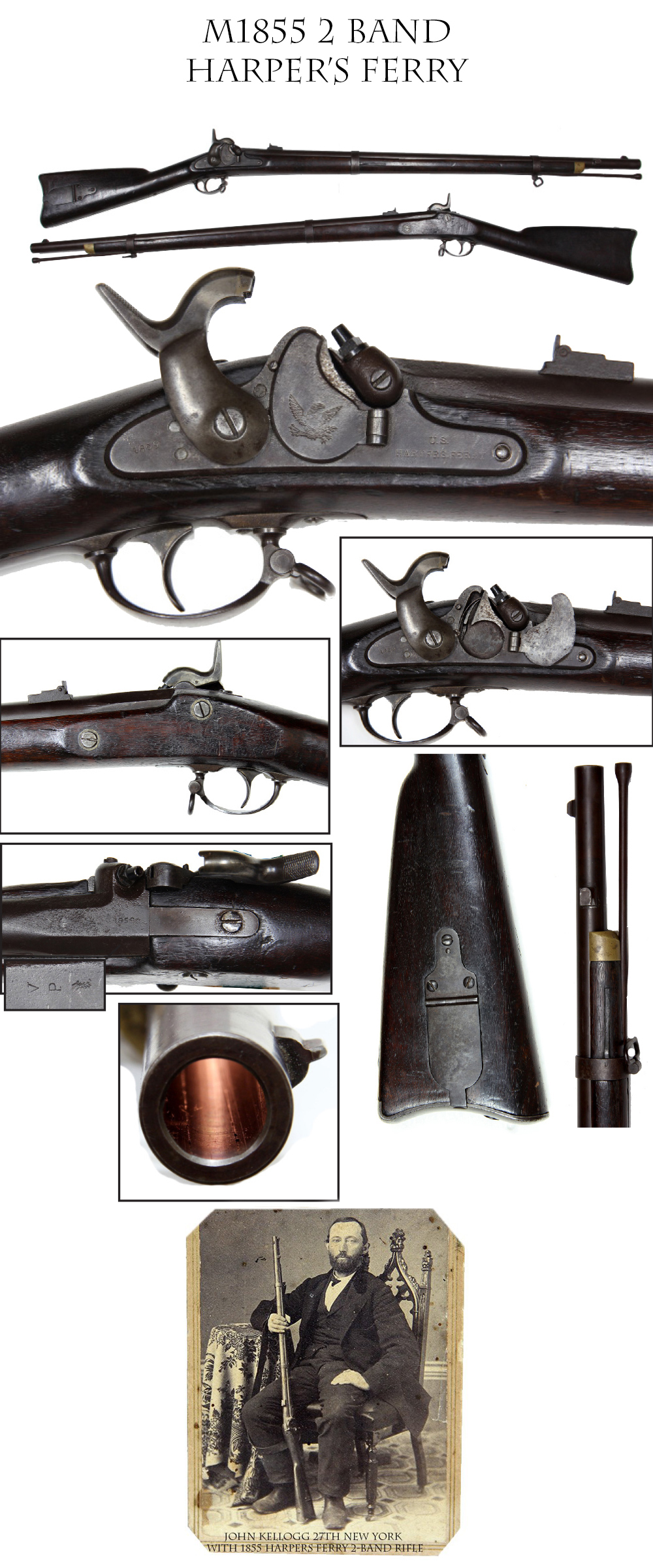
17-08-15…1855 2-Band Harpers Ferry Rifle Dated 1859: THE YEAR OF JOHN BROWN’S RAID…Harpers Ferry always has a cachet as the “southern arsenal,” and the 1855 rifles produced there have always been highly sought, and always been very scarce. They are perhaps 50 times rarer than the scarce 1855 muskets produced at both national arsenals. These 2-band rifles were made only in Virginia at Harpers Ferry. Great numbers were seized by Confederates when they took the arsenal in 1861 and the machinery used to produce them was moved south to manufacture the Fayetteville rifle. This one has matching 1859 lock and barrel dates, with clear V/P/eagle barrel proofs, Harpers Ferry style eagle on the primer door, and a crisp “U.S. / Harpers Ferry stamp on the forward part of the plate. Needless to say, that’s a pretty historic year. This gun was probably in arsenal racks when John Brown tried to seize the arsenal and use its weaponry to arm a slave uprising. The iron patch box is present and opens crisply. The brass nose cap has a nice, undisturbed aged patina. There is a little bit of light salt-and-pepper firing corrosion at the breech, but the metal overall is a smooth brown. The correct short range rear sight with stepped base is present. The front sight and bayonet lug for the saber bayonet are in place. All bands, springs and swivels are there. The rod is the correct rod but is a modern made replacement. The relined bore is excellent. An NSSA skirmisher used this rare rifle in competition after having Hoyt or similar outfit line and re-rifle the bore for precision shooting. The barrel is totally original with original marks. The bore was simply lined and re-rifled thirty to fifty years ago. The wood is dark brown and very good, with just some slight rounding to the edges of the lock apron. The lock plate is a faded pewter gray with some lighter gray showing along the front edge next to the primer door. This is a very nice example of an incredibly scarce, good-looking, key U.S. military shoulder arm produced on the eve of the Civil War, and one that witnessed a key opening event of the conflict…. $4,950.00
Call us @ 419-842-1863
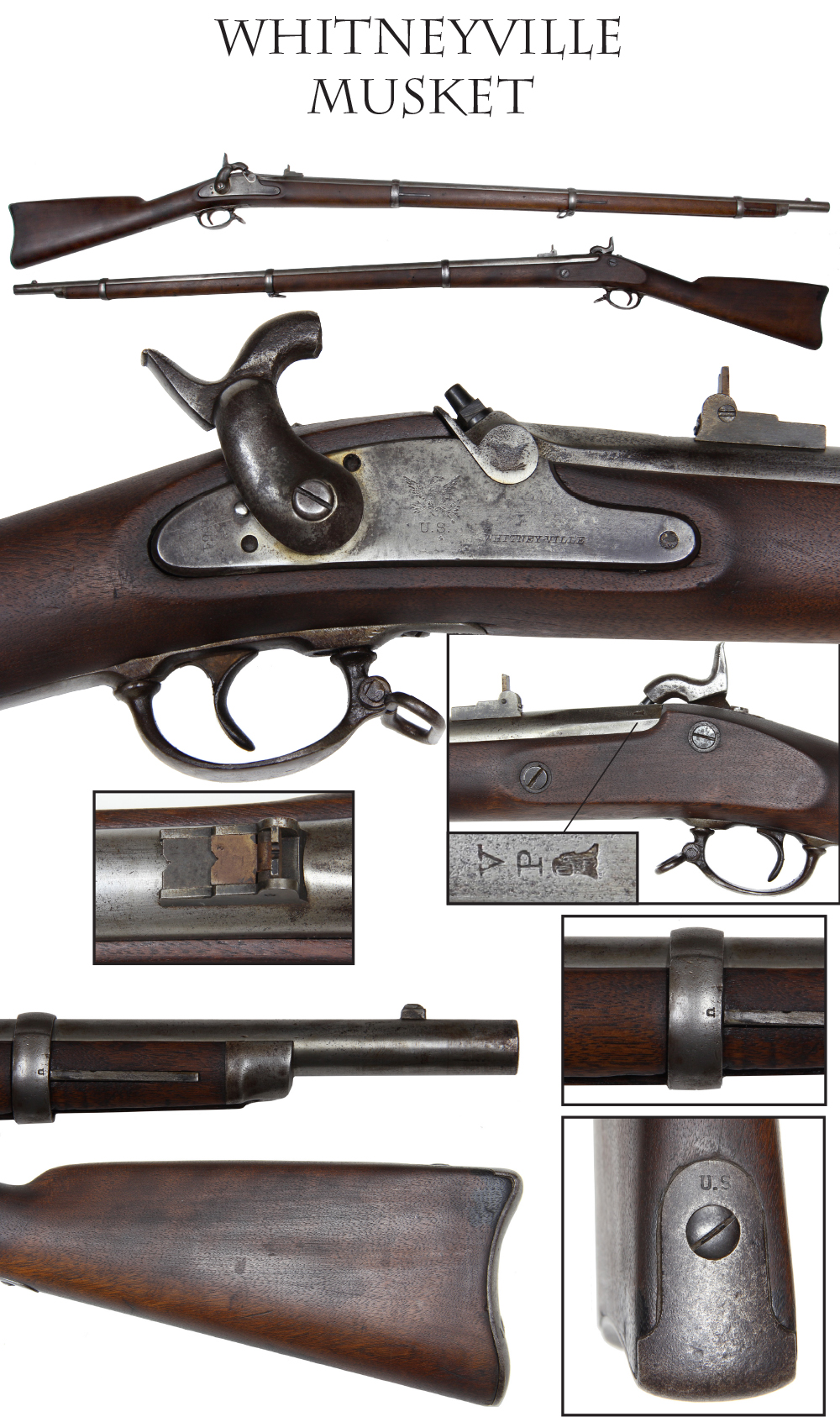
17-08-16…WHITNEYVILLE RIFLE MUSKET… A wonderful example of Yankee Ingenuity “Whitney Style”. Whitney had a sort of “spaghetti against the wall” approach to arms supplying. His muskets often used odd parts he gleaned from a variety of sources, including the US Arsenals. This musket is a Springfield M1863 which has been married to a Whitneyville M1861 lock, with the M1861 hammer severely canted to properly strike the nipple. I have no idea whether Whitney or another arms seller sold this “good and serviceable”… I will leave that bit of detective work for you. When Whitney obtained a second US contract in October, 1863, for 15,000 1861 pattern rifle muskets, his first guns had been sitting around from the earlier contract and the remainder, true to form, show a number of variations. This is a good example of the second pattern of lockplate markings he used, a more conventional eagle and US with “Whitneyville” forward of the hammer and a vertical 1864 date at the rear. The barrel, however, shows an 1863 type bolster with no clean-out screw and stamped with an eagle, and the bands are the round 1863 style. These parts appear to be ex Springfield Arsenal. Metal shows some light peppering near the breech and on the bolster from firing, but is generally smooth and light silver-gray in tone. The lockplate shows a mix of gray and pewter that are the remains of case. The lock markings are crisp, though the bolster eagle shows peppering and the tip of the hammer is a little crusty. Sights, bands, springs and swivels in place. No rod. Short range sight leaf is replaced. Sharp V/P/eagle barrel proofs. Wood is very good. Very slight rounding and a few light wear marks. No significant dents or divots. A little crustiness to the buttplate heel from standing upright on a floor. A classic Civil War long arm and from a famous American gunmaker who is a collecting field unto himself… $825.00
sold
Call us @ 419-842-1863
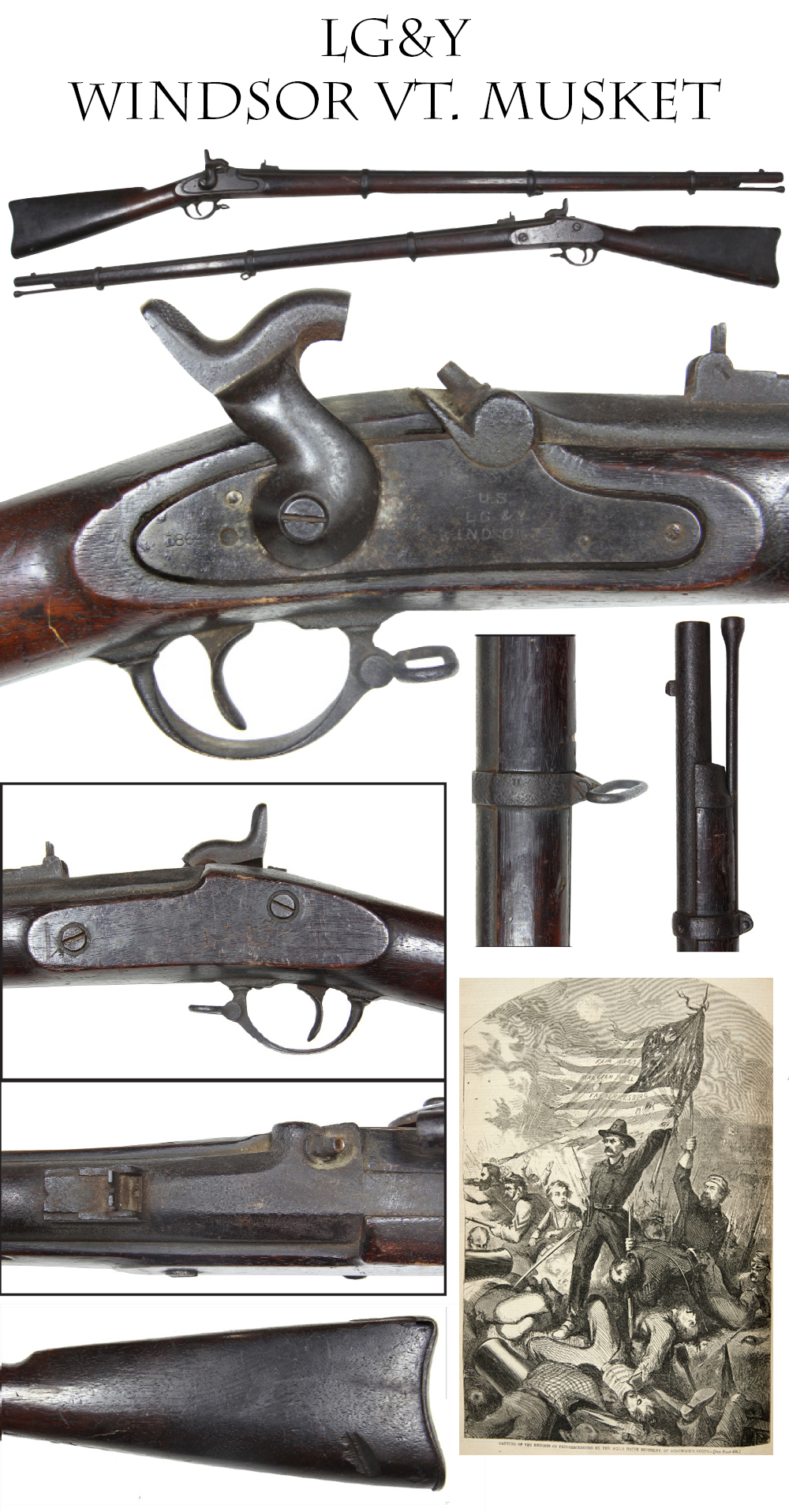
17-08-18.. VERY AFFORDABLE L.G. & Y. WINDSOR VERMONT SPECIAL MODEL 1861 RIFLE MUSKET… Three rifle musket contractors were a bit ahead of Springfield in terms of 1860s arms design. Lamson, Goodnow and Yale of Windsor, Vermont, along with Amoskeag in NH, and Colt in CT. made the US Special Model 1861 Contract Rifle-musket that was introduced by Colt, based on some aspects of the British Enfield. These “improvements” were later adopted by the US in the Springfield 1863 and 1864 patterns. The Special model, has the beveled hammer and uses of a solid, flat faced bolster, as opposed to the goose neck hammer and teardrop bolster on the 1861 Springfield. These were wise improvements and adopted by Springfield in 1863. It also uses screw-tightened, friction barrel bands which was a terrible idea, and discarded forever by Springfield after it tried them in 1863. L.G. & Y. produced about 50,000 of these longarms. This one shows their 1864 lock plate markings, using the 1864 date aft of the hammer and a three-line maker stamp forward. The gun is in appealing crusty, untouched attic condition with dark metal, and some light scattered pitting overall and firing corrosion at the breech and bolster. The wood shows a slight gouge at the left butt flat near the lower rear edge, but retains sharps edges. Sights, bands, swivels and rod are in place. 100% original and complete. This is a real untouched Civil War infantry rifle as they used to show up from family estates, brought back by a soldier after his wartime service and simply put away in the attic. Of some curiosity is the presence of a medium size lead shotgun pellet embedded in the comb of the stock. Perhaps the result of combat with reb cavalry armed with “sawed-offs”. It is a completely honest, un-messed-with Civil War veteran with much appeal. This one was really there for sure, and won’t break the bank … $1,150.00
sold
Call us @ 419-842-1863

17-08-19… US COLORED TROOPS RELATED 4th Mass Cavalry Presentation Sword … Iron hilted US import saber by Clauberg of Solingen in the style of the British 1823 pattern with a backstrap, knucklebow and two outboard branches, and a small inboard loop on the counterguard. “W. Clauberg” over a standing knight, over “Solingen” on the ricasso. Blade is nice, with good edge and point, and with visible etched panels: a “US” amid floral scrolls on one side and an American eagle with an “E Pluribus Unum” ribband on the other side. Blade overall shows a dull silver mixed with bright. Nicely engraved in a flowing script on the scabbard beneath the throat is: “Presented/ Lieut. Benj. Thomas / 4th Mass. Cavl. By the Phoenix Club” The Phoenix Club was a social club in Hingham, Mass., formed first in 1849 that adopted that title in 1856. It was largely engaged in organizing sociable, fancy dress-balls and 4th of July parades. The 4th Mass Cavalry was organized in February, 1864, by combining a battalion of the 1st Mass Cavalry with two other battalions formed in February and April. The battalions operated largely on their own during the war. Company C was part of the 2nd Battalion commanded by Major Keith and was sent to Hilton Head, where it took part in an expedition up the Ashepoo River in May. Two of the companies were then sent to Florida, where they were active in a number of expeditions and skirmishes, as were the two that remained on Hilton Head. The regiment lost 4 officers and 28 enlisted men killed or mortally wounded in their engagements. Thomas was from Hingham, Mass. and enlisted 12/17/63 as a Second Lieutenant and was commissioned in Co. C on 1/6/64. On 2/1/64 he was promoted to First Lieutenant and Quartermaster, which indicates he had some education and talent for organization. At some point he was even promoted to Acting Assistant Quartermaster for the Tenth Army Corps. He served through 12/9/64 and after the war he was a member of G.A.R. Post 29 in Waltham, Mass. He supplied a memoir of his service to the town’s history its service in the Civil War: In November, 1863, Lieut. Thomas received an appointment as recruiting-officer; and, in the following December, was commissioned second lieutenant. Located at the time in Boston, he continued the work of enlistment; and, being quite successful, was commissioned Jan. 1, 1864, as first lieutenant, and assigned to the Fourth Mass. Cavalry as quartermaster. In April, 1864, with the regiment, was ordered to report to Gen. Gilmore, then in command of the Department of the South, with headquarters at Hilton Head, and three days after again embarked under orders to report at Fortress Monroe. His next destination was City Point, for the purpose of co-operating, under Gen. Butler, with all the armies of Virginia, in the “on to Richmond” movement of that year. Being the advance guard to City Point, the duties were numerous and the labor severe. Thomas, as quartermaster, was required to be constantly on the move. Besides being responsible for the supply of rations for men and horses, and other material for the general prosecution of the war, a further duty was imposed as “ordnance officer,” by appointment of the colonel commanding. Soon after there came an acceptable change, in being detailed as A. A. Q. M. of the Tenth Army Corps, under Gen. Terry. Here he continued his labors until, by order of Gen. Butler, the corps was disintegrated, and united with others. Following this movement, Lieutenant Thomas, with other staff officers, was ordered to report to Gen. Weitzel, who had just been placed in command of the Twenty-fifth Corps, composed of twenty-five thousand colored troops. Some disaffection was created with respect to the classing of white troops with colored. Thomas affirms, that, during his entire experience, he found neither better nor braver men than the colored troops. In November and December of 1864, he aided in fitting out the noted Fort Fisher expedition under Gen. Butler, the result of which is well known. At the close of the year, he resigned on account of repeated domestic affliction. He retired from the service, having performed all and more of his complex and often perplexing duties. This is a nicely engraved presentation sword carried by an officer in a post that did not carry a lot of glory but immense responsibility. Inscribed cavalry officer’s sabers to cavalry officers are pretty darn scarce. $2,850.00
Call us @ 419-842-1863

17-08-20… Extremely Rare French Contract P-1853 Enfield Rifle Musket: In the forty five years I have collected and traded antique guns, this is the first of these unsigned French Enfields I have owned. Classic P1853 Enfield in overall VG ++ condition. The barrel has many interesting proof marks including a cartouched “D” flanked by two five pointed stars, a crown over P, and letter D inside a vertical oval. A truly top quality contract piece made in France under contract. Rear sight has a crown over F. The underside of the stock is stamped RV in front of the trigger guard tang. 100% original, 100% complete, and mechanically perfect. These French Enfields were used in the Crimean War (1854-1856), and with France’s close ties to the Confederacy they have a Southern connection as well. A very solid Enfield and darn scarce… $1,950.00
Call us @ 419-842-1863
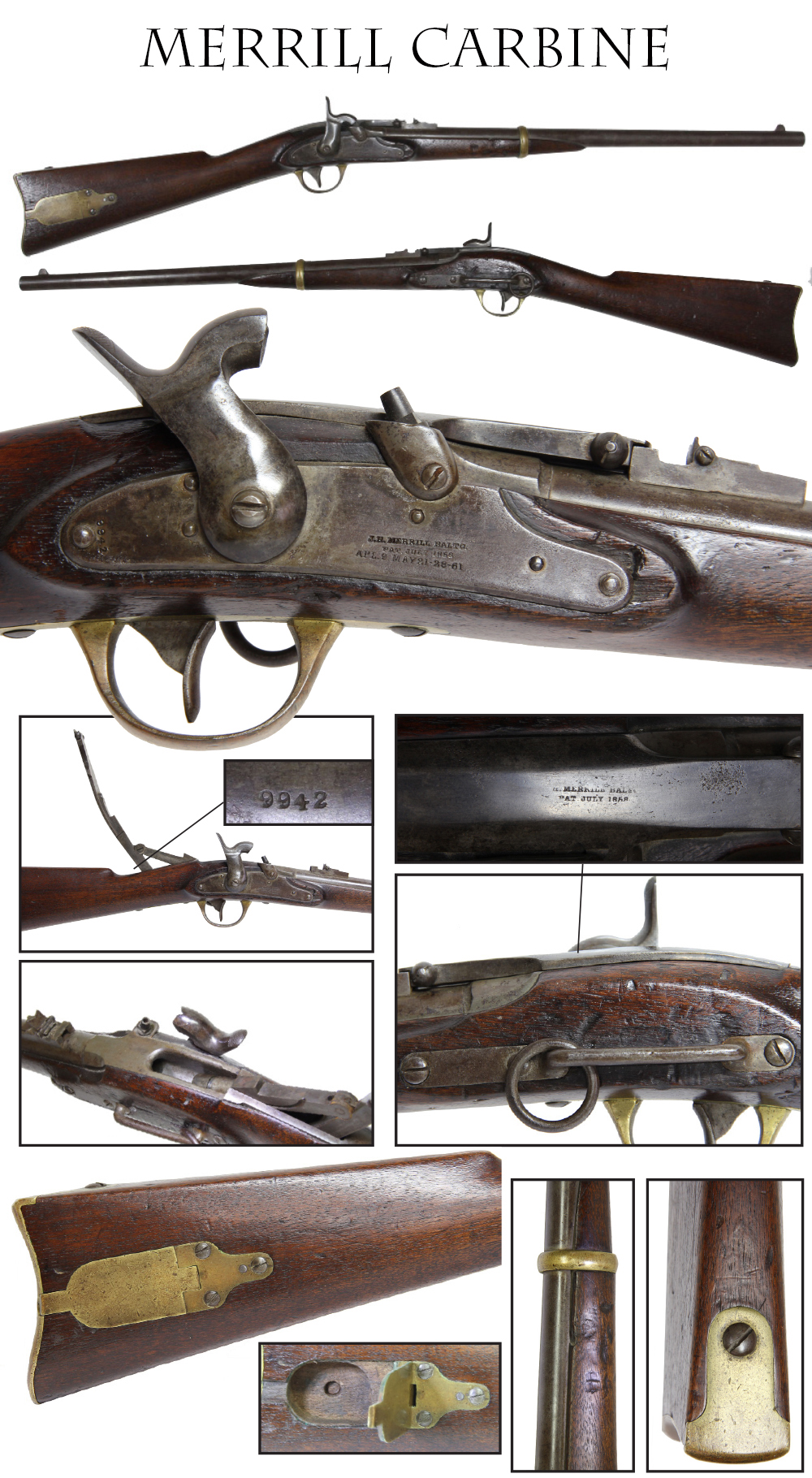
17-08-21…..FIRST MODEL MERRILL CARBINE…These breech loading, .54 caliber, Baltimore-made carbines were issued to the 1st, 5th, 18th NY cavalry; the 11th, 17th, 18th Pennsylvania, and other units. 99% of surviving examples show evidence of wear from actual wartime use. The Merrill is one of the most difficult guns for collectors to find in high finish or “minty” condition, because nearly all were carried in the Civil War. In 45 years I have found only ONE in near mint condition. That was thirty odd years ago and I wish I had kept it. These things saw heavy use. Flayderman says that only 14,495 were produced during the war. Many were produced before the war and were used by Virginia confederates. I have owned two 100% documented Merrill’s carried by Virginia Confederate troopers. They are perfect to display with Confederate artifacts as well as Union. A hinged loading arm raises up on top and draws back a plunger allowing insertion of a cartridge and rams it tightly home when closed. This one is serial number 9942 and follows Merrill’s first model, having a brass patchbox and bearing the serial number at the rear of the lock plate. It has the improved second-type button head latch on the breech lever. Clear Merrill patent stamps on the lock; visible but slightly rubbed on top of the lever. Some chips out of the forward edge of the lock platform and some handling dings on the offside under the sling ring bar and two dings just aft of the barrel band on the right. Wood has a tight fit to the metal. Barrel shows a dull, pewter gray. The loading assembly shows some rubbing to the patent stamp and one small patch of shallow pitting. Nice mellow patina to the brass mounts. A classic early war carbine with true connections to Virginia Confederate troopers. $1,895.00 Sold
Call us @ 419-842-1863
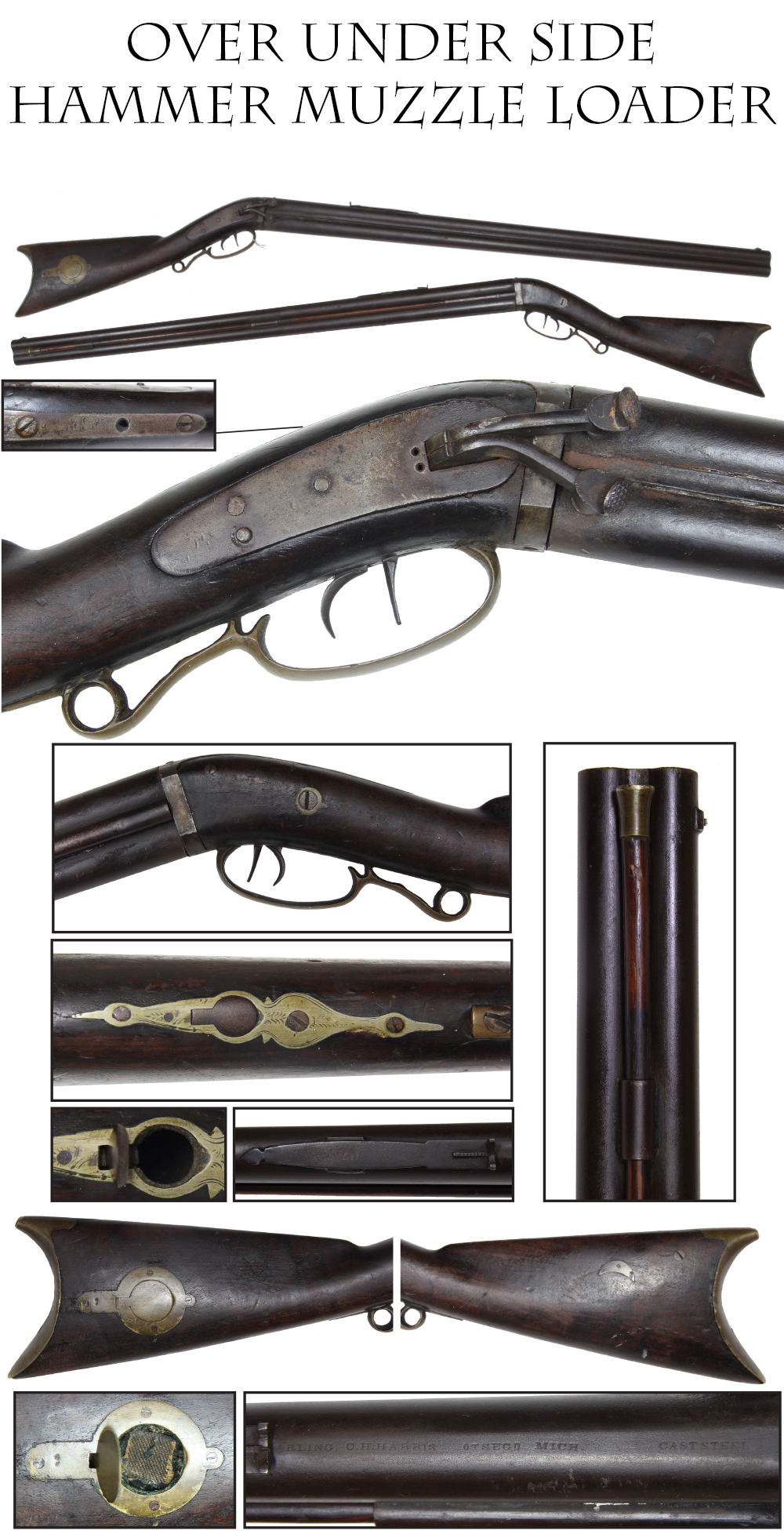
17-08-22…. DARLING AND HARRIS MICHIGAN MADE OVER & UNDER MULE EAR SIDE HAMMER RIFLE & SHOTGUN COMBO:… This gun, is like the wife of the old farmer, who was, “not much for pretty, but hell for strong.” This one sports a 45 caliber rifle barrel over a 12 gauge shotgun barrel. Perfect for even large game like elk which once were plentiful in Michigan. The mechanism is simple and effective. The upper barrel is stamped “ ..]rling. C.H. Harris Otsego Mich” on the top (and also marked “cast steel,”) the left being partly obscured by the long rear sight. This is certainly the mark of William K. Darling and C.H. Harris, who worked as gunsmiths in Otsego (Allegan County) Michigan and are recorded in Chapin’s 1867-1868 business directory for the state, though they were certainly in business much earlier. This gun must have been a good one and well liked by the owner. The tang has provision for a lollipop peep sight in addition to the standard sights present on the top of the barrel. Double set triggers actuate the side hammers. The top hammer cocks and functions. The shotgun hammer has good spring tension but the sear is worn and it will not stay on cock. The ramrod is side mounted on the left. The trigger guard is rather crudely cast, and the gun is decorated sparsely with a small brass patch box in the right butt, which still has some patches in it, a small compartment on the underside behind the trigger guard tang for caps, and an inlaid silver crescent moon on the left butt flat. The lock is mounted with a single side screw. A wood screw shows on the upper left butt flat just forward of the brass crescent butt plate, but what its function was is unclear since there is no repair, and it doesn’t appear to secure any part of portion of the gun. A very folky rifle, full of character circa 1860. $900.00
sold
Call us @ 419-842-1863
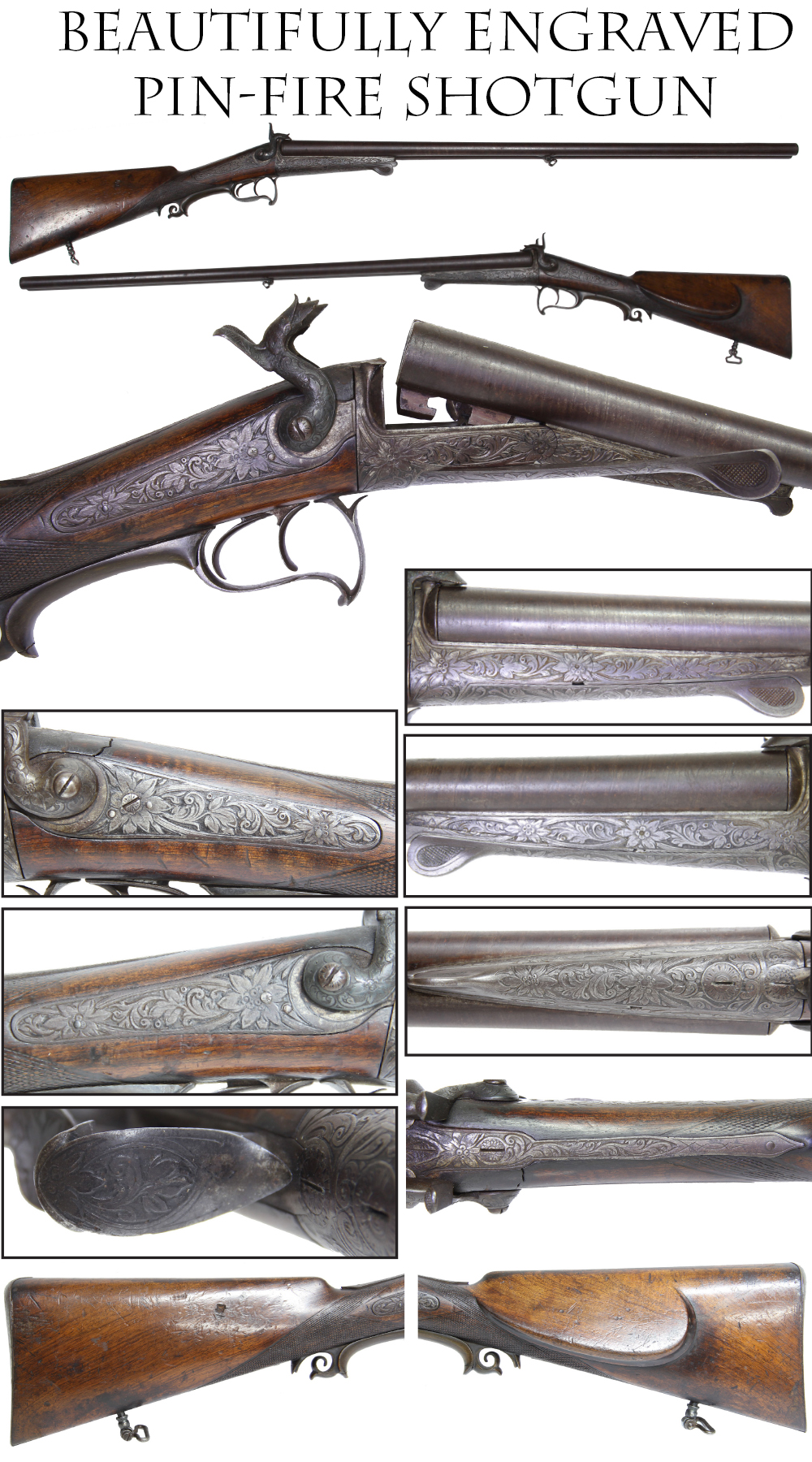
17-08-23… BEAUTIFULLY ENGRAVED PIN-FIRE SHOTGUN… Pinfires are not usually my thing, but I could not pass up this high grade shotgun when I had the chance to buy it. Beautifully executed floral engraving covers the back action lock and receiver. Even the hammers are chiseled to match. The re-curved trigger guard and handrail pick up the scrolling movement of the engraved motifs, unifying the design of the whole gun. Butt stock in very good condition, with high, raised cheek rest. Sling swivels firmly in place. Barrels are muted pewter patina and plum brown showing striations of a Damascus twist. Small crack in the wrist to the left of the barrel tang. This is one elegant hunting weapon that would look superb on the wall. A million dollars worth of “pretty” for $695.00
sold
Call us @ 419-842-1863
Layaways are Welcome
Need to split your order into multiple payments? No problem! A simple 20% earnest money deposit will hold your item for you.-acf
You can then pay it off in easy installments that fit your budget.
Read Terms Here
Items to Sell? Contact Us
I am always interested in buying ANYTHING from the American Civil War… Guns, Swords, Civil War Muskets, Knives, Uniforms, Flags, Medals, Badges, Diaries, Letters, Autographs, Buttons, photographs, tintypes, daguerreotypes, Insignia, Camp Items, Battlefield Relics, canteens, Drums, Etc… Call 419-842-1863 and ask for Dave Taylor.

